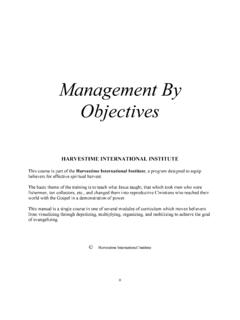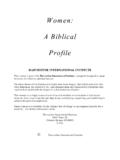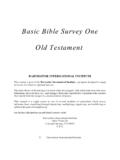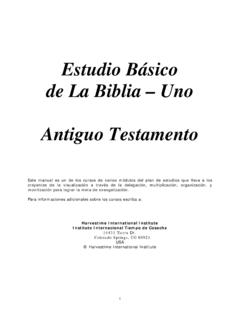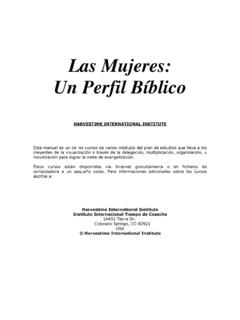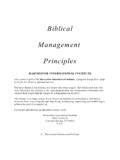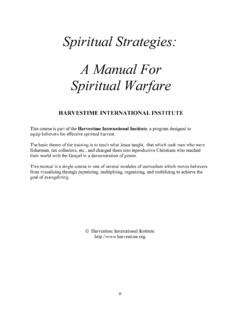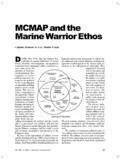Transcription of Principles Of Environmental Analysis - amesbible.org
1 Principles Of Environmental Analysis HARVESTIME INTERNATIONAL INSTITUTE. This course is part of the Harvestime International Institute, a program designed to equip believers for effective spiritual harvest. The basic theme of the training is to teach what Jesus taught, that which took men who were fishermen, tax collectors, etc., and changed them into reproductive Christians who reached their world with the Gospel in a demonstration of power. This manual is a single course in one of several modules of curriculum which moves believers from visualizing through deputizing, multiplying, organizing, and mobilizing to achieve the goal of evangelizing. Harvestime International Institute 0. TABLE OF CONTENTS. How To Use This Manual .. 2. Suggestions For Group Study.
2 3. Course Introduction .. 4. Course Objectives .. 5. 1. The Environment .. 6. 2. Environmental Analysis .. 16. 3. The Biblical Basis: Old Testament .. 26. 4. The Biblical Basis: New Testament .. 33. 5. Personal Environmental Analysis .. 41. 6. Analyzing A People Group .. 60. 7. Analyzing An Area .. 78. 8. Analyzing A Nation .. 90. 9. Analyzing A Region .. 101. 10. Analyzing An Existing Christian Organization .. 114. 11. A Strategy For Planning .. , 129. Appendix .. 137. Answers To Self-Tests.. 141. 1. HOW TO USE THIS MANUAL. MANUAL FORMAT. Each lesson consists of: Objectives: These are the goals you should achieve by studying the chapter. Read them before starting the lesson. Key Verse: This verse emphasizes the main concept of the chapter. Memorize it.
3 Chapter Content: Study each section. Use your Bible to look up any references not printed in the manual. Self-Test: Take this test after you finish studying the chapter. Try to answer the questions without using your Bible or this manual. When you have concluded the Self-Test, check your answers in the answer section provided at the end of the book. For Further Study: This section will help you continue your study of the Word of God, improve your study skills, and apply what you have learned to your life and ministry. Final Examination: If you are enrolled in this course for credit, you received a final examination along with this course. Upon conclusion of this course, you should complete this examination and return it for grading as instructed.
4 ADDITIONAL MATERIALS NEEDED. You will need a King James version of the Bible. 2. SUGGESTIONS FOR GROUP STUDY. FIRST MEETING. Opening: Open with prayer and introductions. Get acquainted and register the students. Establish Group Procedures: Determine who will lead the meetings, the time, place, and dates for the sessions. Praise And Worship: Invite the presence of the Holy Spirit into your training session. Distribute Manuals To Students: Introduce the manual title, format, and course objectives provided in the first few pages of the manual. Make The First Assignment: Students will read the chapters assigned and take the Self-Tests prior to the next meeting. The number of chapters you cover per meeting will depend on chapter length, content, and the abilities of your group.
5 SECOND AND FOLLOWING MEETINGS. Opening: Pray. Welcome and register any new students and give them a manual. Take attendance. Have a time of praise and worship. Review: Present a brief summary of what you studied at the last meeting. Lesson: Discuss each section of the chapter using the HEADINGS IN CAPITAL BOLD. FACED LETTERS as a teaching outline. Ask students for questions or comments on what they have studied. Apply the lesson to the lives and ministries of your students. Self-Test: Review the Self-Tests students have completed. (Note: If you do not want the students to have access to the answers to the Self-Tests, you may remove the answer pages from the back of each manual.). For Further Study: You may do these projects on a group or individual basis.
6 Final Examination: If your group is enrolled in this course for credit, you received a final examination with this course. Reproduce a copy for each student and administer the exam upon conclusion of this course. 3. Module: Organizing Course: Principles Of Environmental Analysis COURSE INTRODUCTION. This course introduces Principles of Environmental Analysis necessary for organizing and mobilizing spiritual resources for evangelizing. This study stresses the importance of Environmental Analysis in planning strategies to reach the world with the Gospel. " Environmental Analysis " is defined and reviewed in the Old and New Testament records. Instructions are given for doing a personal Environmental Analysis and analyzing people groups, geographic areas, nations, regions of the world, and Christian organizations.
7 This course is second in a series of three in the "Organizing Module" of training offered by Harvestime International Network. "Biblical Management Principles " precedes this course, and "Management By Objectives" follows it. It is recommended that these three courses be studied in their suggested order for proper understanding of the leadership, planning, and organization necessary for effective ministry. 4. COURSE OBJECTIVES. Upon completion of this course you will be able to: Define the term " Environmental Analysis .. Identify purposes for Environmental Analysis . Identify Old Testament examples of Environmental Analysis . Identify New Testament examples of Environmental Analysis . Do a personal Environmental Analysis . Analyze a geographic area. Analyze a nation.
8 Analyze a region of the world. Analyze an existing Christian organization. Explain the "REAP" plan of Harvestime International Network. Use Environmental Analysis to plan strategies of evangelism. 5. CHAPTER ONE. THE ENVIRONMENT. OBJECTIVES: Upon completion of this chapter you will be able to: Write the Key Verse from memory. Define the word "environment.. Describe the first environment of man. Describe the present world environment. Explain what caused the change from the first to the present environment. Identify three ways the present environment affects man spiritually. Summarize God's plan for saving man from this sinful environment. Explain how the environment relates to the mission of the Church. KEY VERSE: And God saw that the wickedness of man was great in the earth, and that every imagination of the thoughts of his heart was only evil continually.
9 (Genesis 6:5). INTRODUCTION. Each born-again believer is called of God to become part of the great spiritual body known as the Church. The main commission given the Church is to take the Gospel to all nations: Go ye therefore, and teach all nations, baptizing them in the name of the Father, and of the Son, and of the Holy Ghost: Teaching them to observe all things whatsoever I have commanded you: and, lo, I am with you alway, even unto the end of the world. (Matthew 28:19-20)..Thus it behoved Christ to suffer, and to rise from the dead the third ..That repentance and remission of sins should be preached in His name among all (Luke 24:46-47). 6. Efforts to fulfill this challenge are affected by something known as "environment. This lesson introduces the subject of environment, defines the term, and explains how the environment relates to the mission of the Church.
10 ENVIRONMENT. The "environment" includes the physical, social, cultural, and spiritual factors which surround a person. It includes all parts of the society in which a person lives, works, and ministers. The physical environment includes the visible material things which surround a man. It refers to the country, city, or village in which he lives. It refers to all that can be seen with the natural eye such as buildings, land, animals, trees, mountains, material possessions, etc. The physical environment may be a dry dessert, cold mountain region, jungle, or island. It may be a very nice environment with mild weather where crops grow easily. It may be a very harsh environment, with bad weather which makes providing adequate food supplies difficult.
